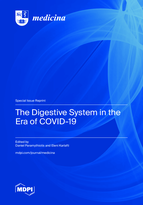The Digestive System in the Era of COVID-19
A special issue of Medicina (ISSN 1648-9144). This special issue belongs to the section "Gastroenterology & Hepatology".
Deadline for manuscript submissions: closed (20 September 2023) | Viewed by 21023
Special Issue Editors
Interests: pancreas; surgery
Special Issues, Collections and Topics in MDPI journals
Interests: emergency medicine; internal medicine; diabetes; hypertension
Special Issues, Collections and Topics in MDPI journals
Special Issue Information
Dear Colleagues,
In the last few years, the scientific world was forced to find ways to manage the SARS-CoV-2 pandemic and its multiple effects. Even though COVID-19 disease was first considered to be a respiratory disease, it was found to have an extended clinical spectrum, with symptoms in many tissues, and it is now identified as a systematic disease.
It is common for SARS-CoV-2 to also infect the digestive system. This type of infection in patients with COVID-19 has a wide symptom range, from asymptomatic expression to some gastrointestinal symptoms that occur with or before respiratory symptoms. Although respiratory infections are known to cause intestinal immune impairment and gastrointestinal symptoms, our knowledge around SARS-CoV-2 and its effect on the digestive system is limited.
The aim of this Special Issue is to evaluate and discuss the effect of SARS-CoV-2 infection on the digestive system, including its mechanisms, clinical manifestations, diagnosis, outcome, and management. The scope of the articles includes but is not limited to the following topics: clinical, laboratory, imaging and prevention, and treatment of COVID-19 digestive disease in different age groups, chronic digestive disease, high-risk groups, and predictors of digestive disease severity.
We invite colleagues around the world to report their experience and knowledge with original studies, case series or case reports, reviews, or mini reviews on "The Digestive System in the Era of COVID-19” to give support to this fundamental area of clinical practice.
Prof. Dr. Daniel Paramythiotis
Dr. Eleni Karlafti
Guest Editors
Manuscript Submission Information
Manuscripts should be submitted online at www.mdpi.com by registering and logging in to this website. Once you are registered, click here to go to the submission form. Manuscripts can be submitted until the deadline. All submissions that pass pre-check are peer-reviewed. Accepted papers will be published continuously in the journal (as soon as accepted) and will be listed together on the special issue website. Research articles, review articles as well as short communications are invited. For planned papers, a title and short abstract (about 100 words) can be sent to the Editorial Office for announcement on this website.
Submitted manuscripts should not have been published previously, nor be under consideration for publication elsewhere (except conference proceedings papers). All manuscripts are thoroughly refereed through a single-blind peer-review process. A guide for authors and other relevant information for submission of manuscripts is available on the Instructions for Authors page. Medicina is an international peer-reviewed open access monthly journal published by MDPI.
Please visit the Instructions for Authors page before submitting a manuscript. The Article Processing Charge (APC) for publication in this open access journal is 1800 CHF (Swiss Francs). Submitted papers should be well formatted and use good English. Authors may use MDPI's English editing service prior to publication or during author revisions.
Keywords
- COVID-19
- digestive system infection
- microbiota
- gastrointestinal involvement
- diagnosis
- management
- disease severity
- mechanisms
- clinical manifestation
- outcome








